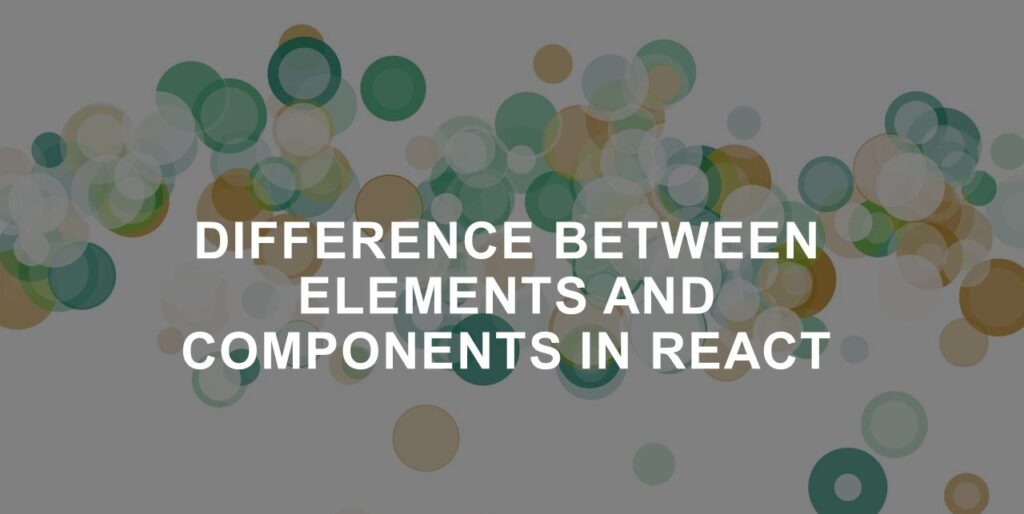React is a popular JavaScript library for building user interfaces, known for its component-based architecture. In React, you often hear the terms “element” and “component” used, but what exactly do these terms mean, and what sets them apart? In this article, we’ll dive into the details to understand the fundamental difference between elements and components in React.
Elements in React
Elements in React are the building blocks of your user interface. They are lightweight and immutable. Think of elements as plain JavaScript objects that describe what you want to see on the screen. Elements are typically created using JSX (JavaScript XML) syntax, which looks similar to HTML but is transpired into JavaScript.
Example of an Element:
const element = <h1>Hello, React!</h1>;In the above code, the element is an example of a React element. It describes a piece of the UI, a <h1> tag with the text “Hello, React!”.
Elements are read-only. Once you create an element, you can’t modify its properties or children. If you want to update the UI, you create a new element and pass it to React for reconciliation.
Components in React
Components, on the other hand, are reusable and composable building blocks. They are like JavaScript functions that take in inputs (called “props”) and return React elements. Components allow you to break down your user interface into smaller, manageable pieces, making your code more organized and maintainable.
Example of a Component:
function Greeting(props) {
return <h1>Hello, {props.name}!</h1>;
}
In this example, Greeting is a React component. It takes a name prop and renders a personalized greeting.
Components can have a state (using the useState hook or by extending React.Component), enabling them to manage dynamic data and respond to user interactions.
Key Differences between elements and component
| Elements | Components | |
| Nature | Elements are lightweight, immutable descriptions of the UI. | Components are reusable, composable building blocks that return elements. |
| Immutability | Elements are read-only; you can’t modify their properties or children once created. | Components can have a state and can update their output based on props or state changes. |
| Creation | Elements are created using JSX or React.createElement(). | Components are created by defining functions or classes. |
| Reuse | Elements are typically not reusable. | Components are designed for reusability and composability. |
Use Cases for React Elements
Static Content
React elements are often used for rendering static content that doesn’t change during the lifetime of the application. For example, rendering headers, footers, or unchanging UI elements.
const headerElement = <header>Welcome to My App</header>;Conditional Rendering
Elements can be employed for conditional rendering. You can conditionally create and render different elements based on specific conditions in your application.
const messageElement = isLoggedIn ? <p>Welcome, User!</p> : <p>Please log in.</p>;Lists and Iterations
When rendering lists or iterating over data, you often use elements to map data to elements to display each item.
const items = ['Item 1', 'Item 2', 'Item 3'];
const listElements = items.map((item, index) => <li key={index}>{item}</li>);
Use Cases for React Components
Reusability
Components are designed to be reusable. Use them to encapsulate UI elements or functionality that you need to use in multiple places within your application.
// Reusable Button component
function Button(props) {
return <button>{props.label}</button>;
}
Complex UI
When building complex user interfaces, components help break down the UI into manageable, self-contained units. Each component can handle a specific part of the UI, enhancing code organization and maintainability.
// Complex UI broken down into components
function UserProfile() {
return (
<div>
<UserProfileHeader />
<UserProfileDetails />
<UserProfileActions />
</div>
);
}
Dynamic Data Handling
Components can manage dynamic data, maintain their own state, and respond to user interactions. This makes them ideal for building interactive features, such as forms or dynamic data displays.
// Component with state to handle user input
function Counter() {
const [count, setCount] = useState(0);
return (
<div>
<p>Count: {count}</p>
<button onClick={() => setCount(count + 1)}>Increment</button>
</div>
);
}
Custom Logic
Components can encapsulate custom logic, making them suitable for implementing features that require specific behavior. For instance, creating a custom image slider or a chat widget.
// Custom logic within a component
function ImageSlider({ images }) {
// Implement custom logic to handle image transitions
// ...
return (
<div>
{/* Render images and controls */}
</div>
);
}
Conclusion
In React, understanding the difference between elements and components is fundamental to building effective and maintainable user interfaces. Elements are the static, unchangeable descriptions of your UI, while components are dynamic, reusable units that can update and respond to changes in the application’s state. By leveraging both elements and components effectively, you can build robust and flexible React applications.
React elements are best suited for rendering static content or conditionally rendering elements, while React components shine in scenarios that require reusability, managing complex UI, handling dynamic data, and encapsulating custom logic. The choice between elements and components depends on the specific requirements of your application and how you want to structure your code for maintainability and flexibility.
![]()




